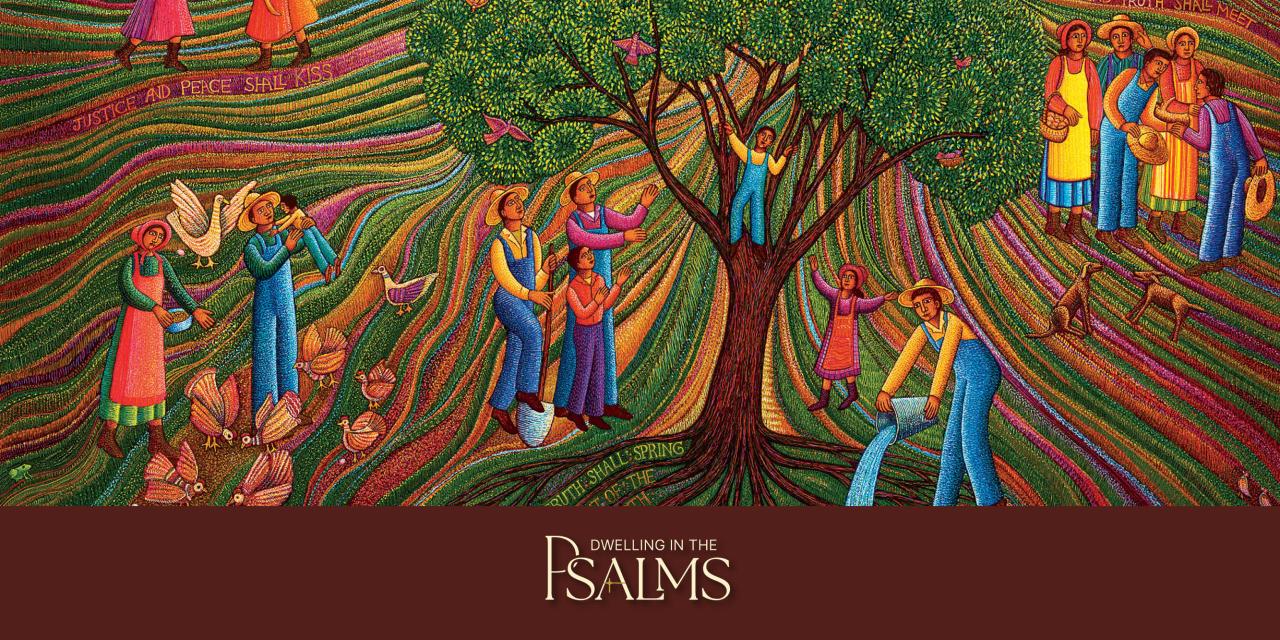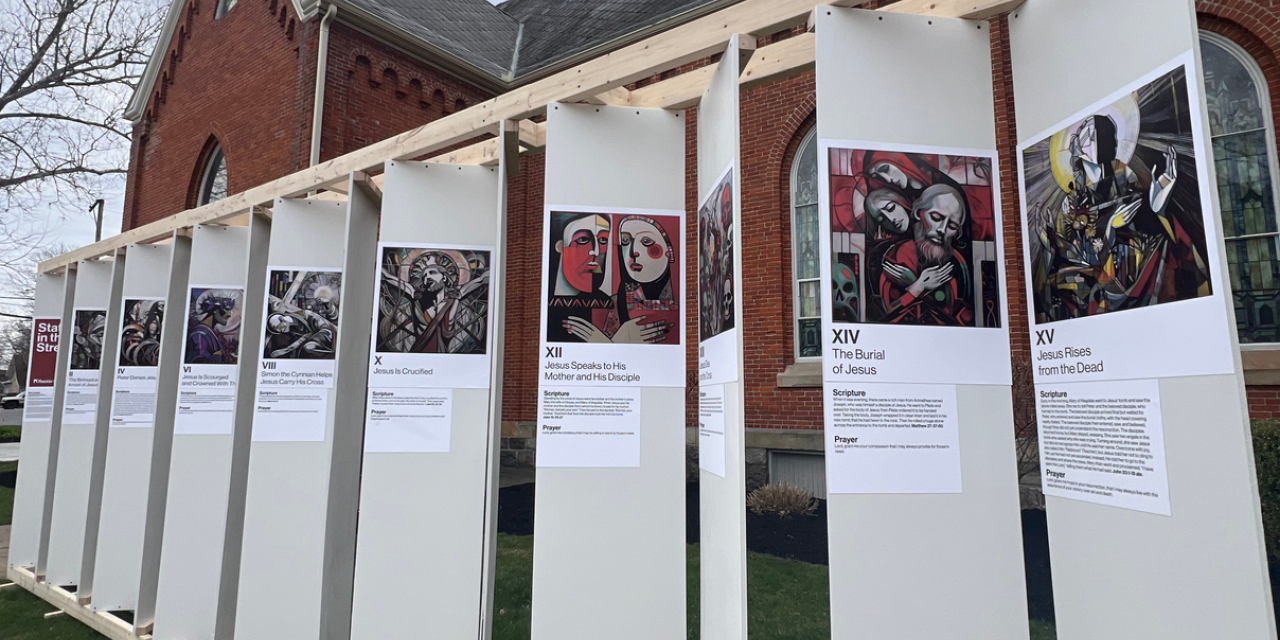
Becki Graves is director of worship arts at Bethel University in Mishawaka, Indiana, and pastor of worship at Restōr Church, a nondenominational church plant in Goshen, Indiana. Chad Jay chairs the art department at Bethel University and directs its Weaver Art Gallery. Graves and Jay designed Via Crucis, a Lenten project made possible by a 2024 Teacher-Scholar Grant from the Calvin Institute of Christian Worship’s Vital Preaching, Vital Worship Grants program. In this edited conversation, they explain how they designed Via Crucis to be interdisciplinary and ecumenical.

What did your grant project involve?
BG: We wanted to create an experience that celebrates many faith traditions through the historical movements of the church. It would engage students across many disciplines and build community among churches in the greater South Bend area of Northern Indiana.
Creating Via Crucis to draw people deeper into Lent was the brainchild of Chad Jay and me. He suggested pairing visual art with a worship experience. We chose to use the vessel of Richard Foster’s six streams of historic Christian tradition to create a bridge of understanding and connection between our Roman Catholic and Protestant traditions. Chad Jay created original paintings and digital art to depict the stations of the cross. Other Via Crucis elements included gallery talks, a community devotional book, original prayers, poetry, and music, a Bethel University chapel service, and a public worship service.
How did you get the idea to combine Richard Foster’s six Christian streams with the stations of the cross?
CJ: The idea emerged from my desire to frame the Passion narrative in a way that would resonate broadly across denominational lines. Foster’s framework in Streams of Living Water highlights six distinct yet complementary expressions of Christian life: contemplative, holiness, charismatic, social justice, evangelical, and incarnational.
By linking these categories to the stations, I hoped to create entry points that Protestants, evangelicals, charismatics, and Catholics alike could recognize as authentic ways of following Christ. We didn’t reject or abandon the Catholic devotional practice I grew up with. We reshaped the stations to offer common theological language that could draw diverse communities into shared reflection on Jesus’ suffering, death, and resurrection.
BG: Foster’s work embodies how each stream informs the other. For example, we cannot be contemplative without considering holiness. The model worked perfectly for a university rooted in Protestant tradition to engage the stations of the cross, which are so important in Catholic tradition.
Why did you have fifteen stations instead of the traditional fourteen?
CJ: Many older versions of the stations of the cross have fourteen stations and include elements not described in the Bible, such as Veronica wiping the face of Jesus. I chose to follow the model of the Scriptural Way of the Cross first proposed by Pope John Paul II in 1991. This scriptural version begins with Jesus in the Garden of Gethsemane. It concludes with a fifteenth station: the resurrection. Including the resurrection was especially important to me, because the passion without resurrection risks presenting only despair. This final station shows that death isn’t the end; it points to hope and new life. For students and congregations, it provides a theologically necessary completion of the journey.
“Including the resurrection was especially important to me, because the passion without resurrection risks presenting only despair. This final station shows that death isn’t the end; it points to hope and new life.”
How did you pair Foster’s six streams with specific stations of the cross?
CJ: Two examples demonstrate how Foster’s streams shaped my approach to individual stations. In the first station, Jesus in the Garden of Gethsemane, I drew on the contemplative stream, emphasizing prayer, solitude, and the intimacy of Christ’s communion with the Father. The imagery invited viewers to consider Christ’s anguish not only as a historical moment, but as an opportunity to practice prayerful attention and surrender. In the eighth station, Simon of Cyrene carrying the cross, I engaged the social justice stream to highlight solidarity with the marginalized. Simon’s unexpected act of bearing Christ’s burden becomes a lens for the church’s call to stand with the oppressed and to share in the suffering of others. In both cases, Foster’s framework provided interpretive depth and allowed the stations to speak with fresh resonance across traditions.
BG: The poetry and liturgy written for the communal Lenten service was full of themes from each stream. We drew on the contemplative stream both in writing poems and in including moments of silence for the audience to reflect on specific scriptural stories. We used the social justice stream throughout, especially in Chad’s art for Station Nine: Jesus Meets the Women of Jerusalem. His image references a press photo of a woman in Gaza crying over her dead child. The holiness stream helped us experience Christ holding tension with his humanity and divinity. As Chad guided us through the paintings, he asked us to share in the suffering of Christ.
Why did your project make two distinct sets of images for the stations of the cross?
CJ: I created a large-scale mixed media painting for each station of the cross. We first installed them in the Weaver Art Gallery, where people attended gallery talks and walked through as an embodied devotional practice. The paintings’ layered textures and large scale asked viewers to encounter the stations of the cross with their eyes and their whole bodies as they moved through the space as pilgrims. Later we installed the paintings at St. Paul’s Memorial Church, where they were paired with choral music and poetry in our communal Lenten service.
I also created fifteen separate digital images suitable for being printed in our Lenten devotional book. The grant paid for us to provide the book to homes and churches. For each station of the cross, the devotional book had an image, a Bible passage, a prayer, and one or more daily devotionals by local clergy and nonprofit leaders. This extended the reach of the stations to include both audiences who might encounter them in a gallery or sanctuary and those who would encounter them in the quiet of their own homes.
How did various South Bend churches access the paintings for their own Via Crucis experiences?
CG: Our communal Lenten service was a collaborative devotional event across denominations. It exemplified how the paintings could become a shared resource for local churches, offering a visual path for their own Via Crucis practices. Congregations were able to host the work by contacting the art department directly, which facilitated loans and guided installation needs.
The original paintings concluded their gallery exhibitions in April 2025, but they have not been retired. Churches and organizations can still request to host the work by contacting the Bethel University art department to arrange scheduling and transportation.
Who wrote the devotionals for the book?
BG: This was one of the happiest surprises of the grant! Our grant project called for assembling a community leadership team of nonprofit leaders and pastors. One woman I called shared our project with her local interdenominational clergy group. It turns out that thirty members had already written Lenten devotions, but they were lacking artwork. Chad and I had already planned to create digital stations of the cross artwork to offer to churches. It was a very happy coincidence.
Our grant provided the funds to combine Chad’s art with the devotionals and to supply churches with physical and digital copies. Many churches used the devotional book to walk through Lent together. It was such a pleasure to partner with community leaders.
Can you say a bit about the music and liturgy used in your communal Lenten worship?
BG: I wrote the responsive liturgy. The music ranged from “In monte Oliveti,” by Austrian composer Franz Schubert, to “New Name Written Down in Glory,” by Charity Gayle and David Gentiles. We used “New Name” and Maverick City’s “Revelation 19:1” to celebrate the final station of resurrection.
Our grant commissioned a new arrangement of “Were You There?” by Stephen Martin, chair of Bethel’s music and theater department. His arrangement includes stanzas from the African American spiritual but also incorporates Hebrew words from Psalm 22 that Jesus quoted on the cross, a portion of the classic Good Friday hymn “O Sacred Head, Now Wounded,” and a brief statement of kyrie eleison (Lord, have mercy).
What did Bethel University students learn through this project?
BG: Students learned so much by planning a Via Crucis chapel. Bethel is a Protestant institution, and many students had zero knowledge of the Catholic tradition beyond the word Mass. They moved from asking why we were doing something that is Catholic to saying this was their favorite chapel experience by far.
They also appreciated how the communal Lenten service—the Via Crucis concert—uniquely combined art, music, biblical scholarship, and storytelling from both Catholic and Protestant traditions. All these elements centered on the passion story.
Did you use Via Crucis resources in your congregation?
Yes! I am on staff at Restōr Church, and this was the first time we observed the Lenten season. We used the devotional book to walk through Lent together. Many churches reported that they did the same. We used Chad Jay’s digital art to create Stations in the Street on the sidewalk outside our church.
What first steps might churches take to do a project similar to yours?
BG: The first step would be to look at some of the commonalities. The passion story was the great unifier of us all—we all believed and agreed that Christ was crucified and was raised from the dead. It was so meaningful to learn from differences in how Catholics and Protestants interpret and emphasize stations of the cross scriptures such as Luke 23:28–31 (Jesus speaks to the women of Jerusalem) and John 19:25–27 (Jesus speaks to his mother and John).
Our grant allowed us to do a lot. Without grant support, you can start smaller. Maybe emphasize Holy Week instead of all of Lent. Take a bite-sized attempt and make your project realistic and attainable.
Especially if you are working with several churches on creating something new, be sure to get everyone’s buy-in on how your creations—writing, music, visual art—will be used.
Learn More
Read a Bethel University news story about Chad Jay’s Via Crucis paintings.
Contact Bethel University’s art department to show these paintings in your community.
Contact Becki Graves for the Via Crucis communal Lenten service program and liturgy.
Contact Stephen Martin for his arrangement of “Were You There?”
Learn more about the Calvin Institute of Christian Worship’s Vital Grants, Vital Preaching Grants program.
Check out worship planning resource guides for Lent and Advent.

